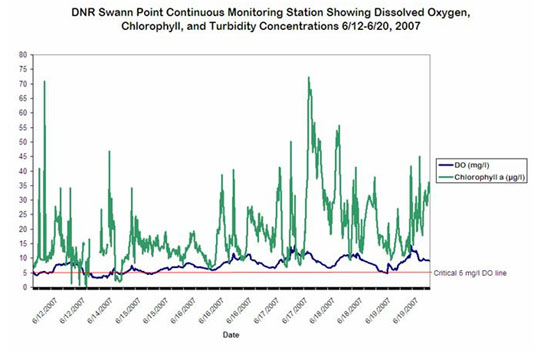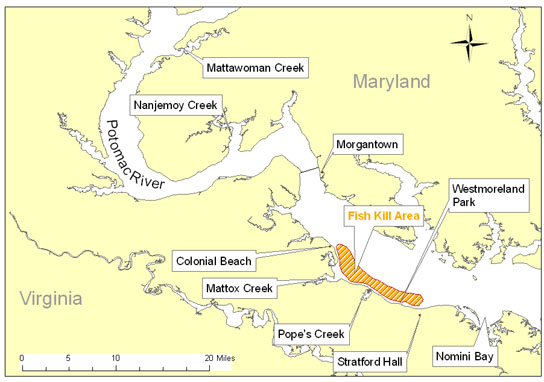|
|
June 11: Staff from the Chesapeake Bay Foundation (CBF) called the Aquatic Health Hotline (888) 584-3110 to report a large algal bloom on the Potomac estuary. The bloom was approximately 2 miles wide and 6 miles long, stretching from the Route 301 Bridge south to Colonial Beach, VA. A few dead fish were reported. Low dissolved oxygen (D.O.) levels (below 1 mg/l) in water below 8 meters deep were reported by the Maryland Department of Natural Resources (MD DNR) field crew who were conducting routine Potomac Shallow Water Monitoring below Nomini Bay down to Point Lookout. D.O. above 8 meters depth was greater than 5 mg/l. D.O. levels below 5 mg/l are considered stressful to fish. No fish kills or significant algal blooms were observed in this area. June 12: The Virginia Institute of Marine Science (VIMS) conducting Potomac Shallow Water Monitoring in the area around Colonial Beach collected an algal sample for species identification. The sample did not contain any toxic algal species. MD DNR field crews were conducting Potomac Shallow Water Monitoring from Morgantown upstream to Mattawoman Creek and did not observe any significant algal blooms or fish kills. CBF staff conducted surveys of the Potomac estuary to evaluate the extent of the bloom. The bloom appeared to extend approximately 30 miles in the lower estuary from the mouth of Nanjemoy Creek to Nomini Bay. Approximately 44 dead fish were reported including gizzard shad, rockfish, and catfish. June 13: A MD DNR field crew sampled the lower Potomac estuary 2 miles below and 2 miles above Colonial Beach. Patchy algal blooms were visible over this 4 mile stretch of the river, especially near the Virginia shoreline. Five plankton samples were collect and the potentially toxic species Karlodinium veneficum was identified with 66,040 cells per ml in one sample and above 10,000 cells per ml in the other samples. Karlodinium can be toxic to fish in concentrations greater than 10,000 cells per ml but is not harmful to humans. The MD DNR field crew reported seeing several dead fish, which is not unusual, but no large fish kill. D.O. levels were all above 5 mg/l in the vicinity of the blooms. The algal samples were sent to Dr. Allen Place at the University of Maryland Biotechnology Institute Center of Marine Biology (COMB) lab for toxicity testing. Dr. Place confirmed the sample containing 14,000 cells per ml contained karlotoxins in low concentrations. Karlotoxins can cause gill irritation and mortality in fish. June 15: A MD DNR field team sampled the lower Potomac R. from Morgantown down to Nomini Bay as part of the monthly Potomac Shallow Water Monitoring Program. The team observed patchy algal blooms, mainly along the Virginia shoreline near Pope's Creek and Maddox Creek. Samples collected in these areas showed algal concentrations of 114ug of chlorophyll. Chlorophyll concentrations above 25-50ug are considered bloom levels. The blooms were not observed in the main channel of the Potomac estuary. Three algal samples collected in the bloom areas contained Karlodinium veneficum at concentrations ranging from 28, 813 to 110,109 cells per ml and were sent to the COMB lab for toxicity testing. Virginia Department of Environmental Quality (VADEQ) personnel collected samples after responding to a fish kill of approximately 100 gizzard shad on the evening of the 15th . The samples were sent to Dr. Harold Marshall at Old Dominion University where Karlodinium veneficum counts were reported as high as 337,500 cells per ml. The real-time MD DNR Continuous Monitor located at Swan Point showed elevated chlorophyll levels (Figure 1), which is an indicator of an algae bloom.
Figure 1. Algal die off on June 13 th resulting in low D.O. and Chlorophyll a values and the subsequent return of better water quality several days later. June 18: MDE responded to a fish kill of approximately 4,000 dead fish representing at least 12 species between Westmoreland State Park and Colonial Beach (Figure 2). Although surface D.O. levels were greater than 5mg/l, intrusion of hypoxic (less than 2.0 mg/l D.O.) bottom water remains a plausible cause of the fish mortalities observed. There was still a significant Karlodinium veneficum bloom presence at Colonial Beach with cell counts as high as 50,000 cells per ml. At the downstream end of Colonial Beach the counts were 1,290 cells per ml- far below the 337,500 cells per ml reported there on June 15th. Virginia Department of Environmental Quality (VADEQ) found the bloom 4 - 6 miles downstream of Colonial Beach at Muses Beach (50,000 cells per ml) and Stratford Hall (45,000 cells per ml). VADEQ observed fish kills comprised of hundreds of hogchokers at Muses Beach and hundreds of gizzard shad at Stratford Hall.
Figure 2. Map showing area of reported fish kills. MD DNR field teams along with their VA counterparts will continue to monitor the entire Potomac estuary and will watch for algal blooms, fish kills, and collect appropriate samples during events. These findings will be reported as they become available on the DNR Eyes on the Bay" (www.eyesonthebay.net) web site.
|


